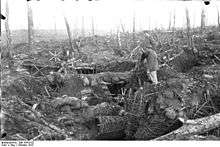Forest of Argonne
The Forest of Argonne is a long strip of rocky mountain and wild woodland in north-eastern France, approximately 200 km (120 mi) east of Paris, France. In 1792 Charles François Dumouriez outmaneuvered the invading forces of the Duke of Brunswick in the forest before the Battle of Valmy.
.png)

During World War I, the forest again became the site of intense military action. Bitter fighting between German and Allied units took place here in autumn and winter 1914, summer 1915 and autumn 1918. During the Meuse–Argonne offensive (1918), several United States Army soldiers earned the Medal of Honor there, including Colonel Nelson Miles Holderman, Major Charles White Whittlesey, Sergeant Alvin C. York – most of them part of the "Lost Battalion", and William Henry Johnson a.k.a. "Black Death".
The World War I Montfaucon American Monument consists of a large granite Doric column, surmounted by a statue symbolic of Liberty. The monument is located twenty miles northwest of Verdun. It is not far from the Meuse–Argonne American Cemetery and Memorial.[1]
Points of interest
See also
References
- American Battle Monuments Commission: Montfaucon monument Archived 2008-09-16 at the Wayback Machine.
External links
![]()